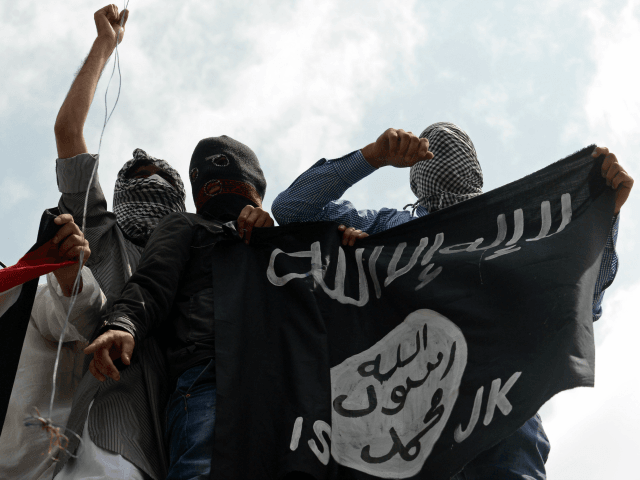The Islamic State (ISIS/ISIL) branch in the Afghanistan-Pakistan region, known as the Khorasan province (IS-K/ISIL-KP), is making an effort to establish “their caliphate” on Afghan soil, according to the top commander of U.S. and NATO forces in the country.
“Right now we see them very focused on trying to establish their caliphate, the Khorasan caliphate, inside Afghanistan,” Gen. John Nicholson, the commander, told NBC News last Friday, adding that the push is “principally a non-Afghan movement.”
Later that day, Brig. Gen. Charles Cleveland, a Kabul-based spokesman for the U.S.-NATO mission in Afghanistan, told Pentagon reporters that U.S.-backed Afghan troops had reduced the number of IS-K jihadists by “15 to 20 percent” to about 1,000 fighters.
“We know that we destroyed multiple command and control locations and logistics locations, and then we also pushed Daesh [ISIS] further south and were able to take some of that territory back,” he also said, referring the ongoing offensive to push IS-K out of its stronghold in the eastern Afghan province of Nangarhar, which sits on the country’s border with Pakistan.
“With our Afghan partners, we’ve been able to reduce that [IS-K-controlled] territory significantly and inflict heavy casualties on them to include killing their leaders,” added Nicholson.
Nearly a week later, IS-K abducted and executed about 30 Afghan civilians in the remote central-western province of Ghor, “in revenge” for the Afghan police killing one of the terrorist group’s commanders, said Abdul Hai Khatibi, a spokesman for the provincial governor.
Reuters notes that the victims appear to have been Kuchi nomads and estimates of their number varied, with the governor’s office putting the total at about 30, the Afghan Taliban saying 36 and some local people saying it was as high as 42.
If confirmed, the executions would mark a major departure for IS-K jihadists who have been largely confined to their stronghold in Nangarhar since they officially announced their presence in the Afghanistan region at the beginning of 2015.
IS-K has claimed responsibility for Monday’s attack on a police training college in Quetta in southwest Pakistan that killed 59 people and wounded more than 100.
Pakistan has dismissed the claims, blaming the Lashkar-e-Jhangvi (LeJ) terrorist group instead and saying that it has “crushed” IS-K’s attempts to expand in Pakistan, notes Reuters.
Khorasan is an ancient name for a region that covers Afghanistan, Pakistan, Iran, parts of India, and other surrounding countries.
Gen. Nicholson has said that the majority of IS-K jihadists are Pakistani Pashtuns, members of the Pakistani Taliban, Tehrik-e Taliban Pakistan (TTP).
He told NBC News that Uzbeks from the Islamic Movement of Uzbekistan have also joined IS-K.
The commander said that IS-K is “completely rejected by the Afghan people,” adding that that the broader ISIS ideology is “the antithesis of Afghan culture.”
Although U.S. President Barack Obama declared the U.S. combat mission in Afghanistan over at the end of 2014, the U.S. military has increased operations against the various terrorist groups in the country, stepping up airstrikes to about 700 this year, surpassing the estimated 500 during all of 2015.
“Of the 98 U.S. or UN-designated terrorists organizations around the globe, 20 of them are in the Af-Pak region,” explained Gen. Nicholson last month. “This is the highest concentration of the numbers of different groups in any area in the world.”
Most (190) of the 230 strikes against “counterterrorism” targets in Afghanistan, which include al-Qaeda and IS-K jihadists, have targeted members of the latter group, Cleveland told reporters.
From the air and the ground, U.S.-backed Afghan troops have been targeting IS-K in its stronghold of Nangarhar for months.
The increase in airstrikes against terrorists in Afghanistan signals “a deeper role for American forces that is expected to continue for the foreseeable future,” reports Reuters.
Brig. Gen. Cleveland explained that about 240 of the approximately 700 airstrikes that occurred between January 1 and October 20 were conducted under authorities approved by Obama in June that allowed U.S. forces to more actively support Afghan troops during strategic combat operations, particularly against the Taliban.
Besides counterterrorism strikes, “other airstrikes can be conducted in defense of U.S. and international military advisors, as well as some Afghan troops,” notes Reuters.
Currently, nearly 9,000 American troops are in Afghanistan, according to the Special Inspector General for Afghanistan Reconstruction (SIGAR), a U.S. watchdog agency.
President Obama has decided to keep 8,400 U.S. forces in the country, rather than reducing the American military presence to 5,500 as previously planned.

COMMENTS
Please let us know if you're having issues with commenting.